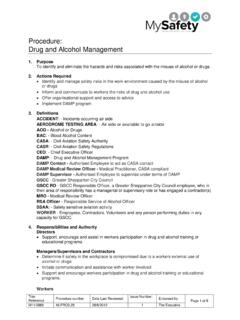Transcription of Procedure: Hazard Identification, Risk Assessment and Control
1 Trim Reference Procedure number Date Last Reviewed: Issue Number: Endorsed by Page 1 of 20 M10/109360 1 The Executive Procedure: Hazard Identification, Risk Assessment and Control 1. Purpose To identify processes, equipment and work areas that may cause injury to workers and visitors and to implement effective controls of the Hazard . 2. Actions Required Identify hazards and implement effective Control measures Audit and review 3. Definitions GSCC - Greater Shepparton City Council GSCC RO - GSCC Responsible Officer, a Greater Shepparton City Council employee, who in their area of responsibility has a managerial or supervisory role over employees, contractors or volunteers SDS - Safety Data Sheet (Also known as Material Safety Data Sheet MSDS) SWMS Safe Work Method Statement WORKER - A person who carries out work in any capacity for GSCC. 4. Responsibility and Authority Directors Delegate appropriate OHS responsibilities and accountabilities to all levels of management Ensure adequate consultation with employees on health and safety issues.
2 Manager/Supervisors and Contractors Undertake Hazard assessments on the working environment, plant items and tasks Ensure workplace inspections are conducted on the required basis to identify hazards Consult with workers on Hazard identification and Control Implement corrective actions to address hazards within appropriate time frames. Workers Identify hazards prior to performing works Maintain a safe work environment Report any identified hazards Seek assistance to manage hazards when required Report immediately any change to plant or site conditions which may affect safety. 5. Procedure Hazard Identification and Risk Assessments Hazard identification is a thorough look at the workplace, work site, operating procedures, equipment, events to identify hazards, things, situations, processes that may cause harm, particularly to people. Hazard identification form an integral part of OHS management and is a thorough look at: hazards who may be at risk (employees, cleaners, visitors, contractors, the public, etc) Existing Control measures.
3 Trim Reference Procedure number Date Last Reviewed: Issue Number: Endorsed by Page 2 of 20 M10/109360 1 The Executive GSCC RO s are responsible for: identify existing and potential hazards determine underlying causes of hazards monitor Hazard controls (personal protective equipment, engineering controls, policies, procedures) recommend corrective action Where Should You Look For Hazards? Who performs the tasks or services and who is affected by us doing them Where the tasks or services take place How the tasks or services are performed What plant and equipment do we use to do the tasks Review regularly Hazard Identification Hazards are identified from a range of sources: Experience of workers who do the work Systems of work being used Work environment (layout, condition, etc.) Plant, site, noise, manual handling and hazardous substances risk assessments Material Safety Data Sheets (MSDS) Work place inspections Hazard and incident reports First aid records Non compliance forms Statutory Notifications (WorkSafe) Other stake holders community, contractors Operational situations as well as non-standard events such as power outages, emergencies etc.
4 Refer various risk assessments in related documents section this procedure. Prioritising Risks After identification is made, evaluate how likely and severe the risk is, then decide what measures should be in place to effectively prevent or Control the harm from happening. Ranking or prioritising risks is one way to help determine which Hazard is the most serious and which Hazard to Control first. By determining the level of risk associated with the Hazard you can decide what controls are required. By assigning a priority to the hazards, you are creating a ranking or an action list. The following factors play an important role: Percentage and frequency workforce exposed Degree of harm likely to result from the exposure probability of occurrence Ranking hazards requires the knowledge of the workplace activities, urgency of situations, and most importantly, objective judgement.
5 Trim Reference Procedure number Date Last Reviewed: Issue Number: Endorsed by Page 3 of 20 M10/109360 1 The Executive Risk Calculator Rating Likelihood (The probability that a risk will occur) Almost Certain 1. Will probably occur, could occur several times per year 2. Event expected to occur several times per year. Likely 1. High probability , likely to occur once per year 2. Will probably occur at some stage based on evidence of previous incidents. Possible 1. Reasonable likelihood that it could occur during a five year period 2. Not generally expected to occur but may under specific circumstances. Unlikely 1. Plausible, could occur in a five to ten year period 2. Conceivable but not likely to occur under normal operations, no evidence of previous incidents. Rare 1. Not impossible, but unlikely at less than a ten year period 2. Only ever occurs under exceptional circumstances.
6 Rating Consequences (Potential Impact risk may have) Catastrophic 1. Loss of life probable and serious injury inevitable. 2. Event/project/activity would never be carried out again. 3. Financial impact could not be managed within corporate budget. Major 1. Loss of life possible and serious injury probable. 2. Most success measures threatened or one severely affected. 3. Significant reworking of corporate budget, including cuts to items. Moderate 1. Loss of life unlikely but serious injury possible. 2. Some success measures affected with considerable effort necessary to rectify. 3. Minor reworking of corporate budget or significant reworking of jurisdictional budget. Minor 1. Serious injury unlikely but minor injury probable. 2. Success measures able to be achieved with some effort. 3. Some reworking of jurisdictional budget required. Negligible 1. Minor injury possible.
7 2. Able to be rectified using management processes. 3. Financial impact easily manageable within jurisdictional budget. Risk Rating Descriptions Extreme Event/project/activity not to start or to cease immediately. Any risk with an assessed level of High or Extreme must have a risk action plan prepared. Trim M12/55653 High Substantial efforts to be made to reduce the risk. Risk reduction measures should be implemented urgently within a defined time period. Any risk with an assessed level of High or Extreme must have a risk action plan prepared. Trim M12/55653 Moderate Consideration should be as to whether the risks can be lowered, where applicable, to a tolerable level and preferably to an acceptable level, but the costs of additional risk reduction measures should be taken into account. The risk reduction measures should be implemented Trim Reference Procedure number Date Last Reviewed: Issue Number: Endorsed by Page 4 of 20 M10/109360 1 The Executive within a defined time period.
8 Arrangements should be made to ensure that controls are maintained, particularly if the risk levels area associated with harmful consequences. Low Must fix the cause(s) when time and resources permit, but within 3 months. Regularly monitor the cause(s) and Hazard until rectified. Insignificant No additional controls are required unless they can be implemented at very low cost (in terms of time, money, and effort). Actions to further reduce these risks are assigned low priority. Arrangements should be made to ensure that the controls are maintained. Control Measures Once you have prioritised the risks, you can decide on ways to Control each specific Hazard Each option from 1-5 is least effective than the previous. 1. First option will be to eliminate the risk stop using a chemical if can do without it 2. Second option is to substitute one risk with another lesser risk use a chemical that is not as dangerous as another 3.
9 Third option is to have engineering controls machine guards, safety switches, reverse beepers, etc 4. The fourth option is to have administrative options use of checklists, safe work method statements, written instructions or training or combination of all 5. The fifth option is to provide personal protective equipment masks, gloves etc. Safe Work Method Statements (SWMS) SWMS is a written document that informs staff of identified hazards, standard operating procedures and Control methods in place. SWMS must be developed for processes where risks have been identified. Four basic stages in preparing SWMS are: Selecting the task to be analysed Breaking the task down into a sequence of steps Identifying potential hazards Determining Control measures to eliminate or reduce the risk of the hazards. Trim Reference Procedure number Date Last Reviewed: Issue Number: Endorsed by Page 5 of 20 M10/109360 1 The Executive Availability of SWMS Completed SWMS must be available to all employees performing the activities and tasks described in the SWMS.
10 Availability of SWMS or work instructions allows workers to review or seek instructions on a required way of performing a job. Issue Resolution flow chart OHS Hazard identified Employee reports Hazard to supervisor/manager, health and safety rep, union delegate or work group meeting. Issue resolved YES NO Issue to be taken to General Manager Issue resolved YES Issue taken to HR, CEO or WorkSafe for final ruling. YES Resolution reported to all staff affected, OHS Committee or OHS Advisor. Can issue be fixed immediately and effectively? Issued Resolved YES NO Employees who have any safety concerns that an activity may cause immediate harm must cease that activity and report it to supervisor, manager. Hazard Corrective Action Form Issue to be taken to OHS Committee. NO Issue resolved NO YES Trim Reference Procedure number Date Last Reviewed: Issue Number: Endorsed by Page 6 of 20 M10/109360 1 The Executive 6.







